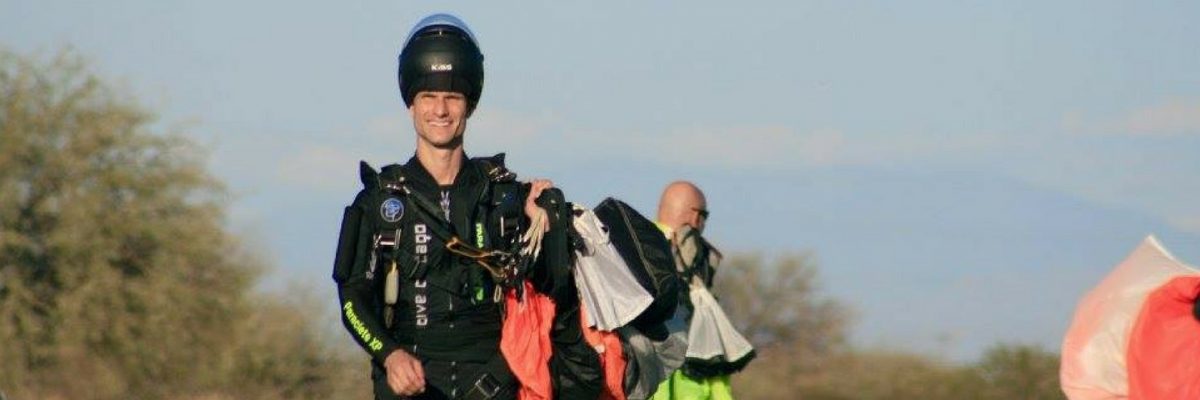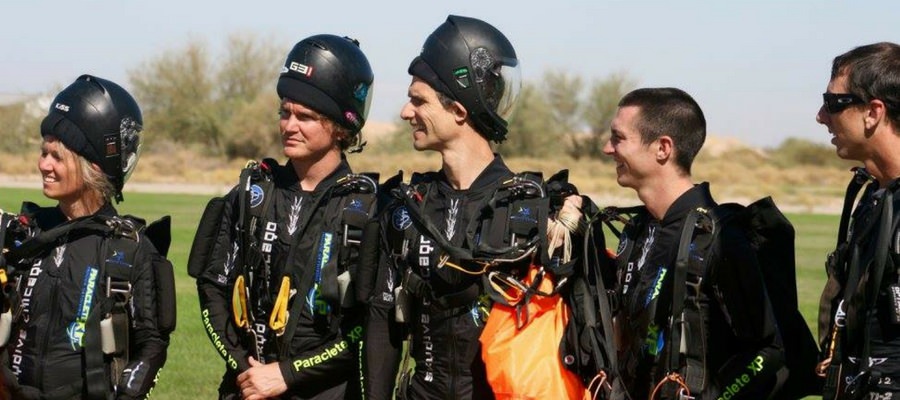
Interview with SDC Rhythm XP’s Steve Lefkowitz
Monday, November 14, 2016
You’re never going to meet another team like SDC Rhythm XP.
Sure, these guys end up on plenty of podiums–tunnel and sky alike–and they’ve just stepped off another one. The team finished with the silver medal in this past month’s USPA Nationals at Skydive Arizona–coming in 2nd with a very high-fiveable 23.8, matching the team’s highest average to date.
It could be argued that the Rhythm difference is just how badly they want to bring everybody else with them to the top. Rhythm’s team members are all professional, full-time skydivers, and they spend a lot of that full-time schedule in coach mode. Beyond contract coaching–and quite uniquely, I might add–the team has done the hard work to build an educational legacy. In 2016, SDC Rhythm XP established the Women’s Skydiving Leadership Network, dedicated to advancing women in the sport through conferences, intensives and one-on-one mentoring.
Suffice it to say: SDC Rhythm XP are a force to be reckoned with, and they have a lot to share.
I had the chance to catch up with Rhythm’s Outside Center, Steve Lefkowitz, to take a peek into the gears of the hard-driving Rhythm machine. Here’s what he had to say.
—–
Q: So: How did you get into the sport?
Steve: [Inside Center] JaNette [Lefkowitz] got into 4-way before I did. We were a couple before either of us started skydiving; we met at college. At some point, JaNette started jumping, but I wasn’t interested. A good amount of time went by–about three years, as a matter of fact–that I would go to the drop zone, hang out and read a book while she was jumping with her team. As time passed, she was getting more and more into it, but I was standing my ground, literally.
In the end, funny as it may be, it was going to the wind tunnel that convinced me to become a skydiver. JaNette had won some free tunnel time, and the time that she and her team weren’t flying–between sessions–would have just gone to waste. Basically, they kind of convinced me to use their “scrap time.” It hooked me. After just a little bit of flying in the wind tunnel, I suddenly appreciated that this was a lot more of a fun, athletic endeavor than I imagined it was–not simply a thrill ride. I got my license.
Q: …So how did you go from being a windytube convert to a key part of one of the sport’s winningest teams?
Steve: Well, once JaNette and I were both skydiving, we were both skydiving as much as we could. We wanted to do a team together about a year into my jumping, and JaNette was very supportive–but nobody else would have me because I wasn’t very good yet. I was so new.
JaNette ended up joining an all women’s team. As that was happening, another team was looking for someone. I think that they didn’t have any other options, so they took me. So I was on one team, and JaNette was on another.
One of the guys from my team, Laurent Beaudouin, and I, ended up getting along very well. By the end of the year, JaNette, Laurent, and I, had really gelled. It became obvious that if we could make a team–the three of us–the following year, it would be great. We asked our coach, Robert Chromy, to become our player-coach in 2007, and then we were Rhythm.
So, the timeline is this: My first year of skydiving: No team. Second year: First team. Third year: Rhythm. We work fast.
Q: This year, you’ve had a couple of new team members come on. What is it like to change the chemistry of the core group?
Steve: It’s a challenge, I think, for any team to keep teammates year after year. Christy Frikken and Mikhail Markine did three years with us. We had a great run, but they were not continuing. To fill the gap, we looked around for who were the best available. That was Doug and Andrew.
We approached them and talked about a plan to join forces. They were up for it. We hadn’t jumped together before–we had competed against each other, sure, and we knew them from the competition community–but we needed to make sure it was a good fit. So we did some tunnel time together and talked a lot about our goals, commitment, and values. It worked wonderfully. Since then, we have done about 730 jumps and about 30 hours of tunnel.
Doug and Andrew competed with us in the Nationals just now, and we took the silver. They’re great teammates. We’re proud and happy to have them.

Q: If you could point out the number one challenge of being a team on Rhythm’s high level, doing all the jumping that you guys do, what would it be?
Steve: Doing our best to make sure we are making the most of our time. That’s a really important challenge, and one that, I think, is easy to lose track of.
It’s easy to get lax. When you’re doing hundreds of jumps a year, and hours and hours of tunnel, you can slip into a pattern of just sort of doing the next jump or doing the next tunnel session, but you can’t just do. You have to be sure to use every minute of training effectively..
At this point, when we are talking about differences tenths of seconds, we really need to make sure everything we are doing is purposeful; deliberate; focused on achieving our goals. That can become a challenge day after day.
Q: Many of the teams at the Nationals are coached by SDC Rhythm XP. What’s it like to be actively training the next generation that’s competing against you?
Steve: We love that. When you do this year after year after year, it has the potential, like anything, to get stale. A lot of what keeps us motivated is not just the drive to be the best in the world, but working on a variety of things we would like to achieve–like contributing to the success of others in the sport through our business and our outreach.
Personally, I get a lot of out of knowing that my season–my day-to-day–doesn’t just consist of my own training, but of contributing to others getting better and feeling good. We are able to connect with people. We are able to contribute to adults feeling good about themselves because of what they are able to accomplish through their hard work.
It feels like that’s a unique aspect of our sport. You don’t see the top basketball or baseball players spending their free time coaching amateur baseball or basketball teams. In this sport, however, we do.
Q: You have a bunch of tunnel camps in the upcoming month. Who are those camps for, and what makes them different?
Steve: They’re for everybody. Really. At every level.
A lot of people, I think, get put off. They think that they don’t need “that level of coaching;” that they can start with something less advanced, and then work up to getting coaching from Rhythm.
I would suggest that there is another way to look at it that might change your approach. The fact that, at Rhythm, we do this full-time–and that we spend so much time thinking about not only our own competition and our own development, but on how to better instruct others–makes us good at helping people at any level progress the quickest. We’ve honed our teaching skills and our curriculum in the tunnel in a way that others haven’t been able to because they just don’t spend the same time we have.
We coach everyone. We coach people who don’t even have their A license, and we coach the people who are aspiring to beat us. We coach people who have never made a skydive, and we coach people who have 30 years in the sport and thousands of jumps.
We coach hundreds of hours a year–and have for almost a decade now. That gives us the advantage of having seen a million different ways people learn; catch on; make mistakes. It has shown us the teaching tools that are the most effective, and it has given us a wide variety of tools so when one approach doesn’t work, we can move on to another that will. =Also, as skydivers in addition to tunnel coaches, we know how to make sure that what we teach applies not only in the tunnel but in the sky as well.
Often, also, our tunnel events are part of a broader plan that people can participate in; a plan that’s designed to help the flyer achieve his or her long-term goals. That may include a series of tunnel workshops combined with jumping events that become increasingly more challenging over the course of months and years.
Q: You and JaNette both worked in high-level IT consulting before you became full-time skydivers. How does your business background inform your work with Rhythm?
Steve: We take what we learned from that and apply it to our training as much as possible. At the beginning of the year, we put together a training plan that resembles a business plan. The plan starts with a very high overview of our goals and our resources. Then we break that down into a series of phases for the year, and then break that down even more into camps, and then, even more specifically, down to the day level.
I think that being very organized and proactive about planning helps us most of all to focus our efforts and make sure every jump–and tunnel session–counts.
We’ve seen a tremendous amount of talent, interest, and drive in this sport. We’ve also seen instances of great professionalism. However, there’s not always a ton of both of those elements together. At Rhythm, we’re constantly doing our best to marry the hard work, determination, and talent with the same professionalism that was such an important part of our toolkit in the business world. Whether it applies to our training plans, our camps, or the day-to-day process of steering our competition team, we work hard to be not only the most knowledgeable and best teachers of skydiving, but also the most professional. We try to make that our differentiator.
Tags: skydiving competition

Thanks so much for a wonderful first time adventure for me and my 5 year old great-niece; and also my 2nd timer niece. I felt very safe and informed through the whole process. My only wish is that we had ParacleteXP in Minnesota-with you to guide us! Thanks again for a wonderful time. We will DEFINITELY be back next time when in NC.
Ellen Adams
Copyright © 2025, Paraclete XP Indoor Skydiving, All Rights Reserved.
DropZone Web Design & Marketing by Beyond Marketing, LLC